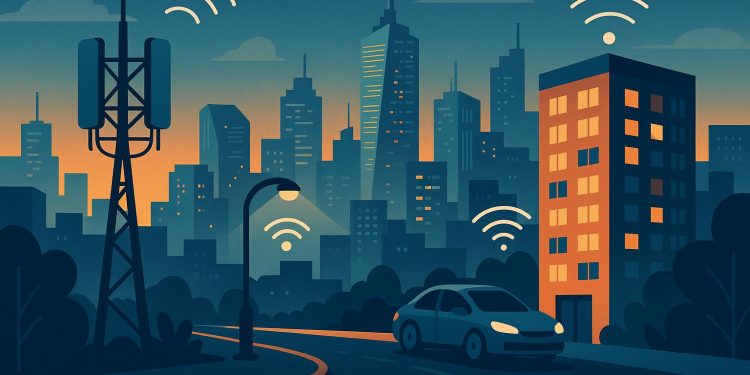The rise of smart cities marks one of the most exciting intersections of technology, urban planning, and real estate in recent history. At the heart of this transformation lies the telecoms sector, whose infrastructure and innovation are enabling the connected urban environments of the future. As data becomes as vital to cities as water or electricity, property developers and telecom providers are learning that collaboration is no longer optional—it’s essential.
The Evolution of Urban Connectivity
A decade ago, conversations about property development focused mainly on transport links, energy efficiency, and architectural design. Today, digital connectivity sits alongside these as a defining feature of modern infrastructure. High-speed broadband, 5G networks, and integrated Internet of Things (IoT) systems now form the digital backbone of new developments.
Cities such as London, Manchester, and Birmingham are already experimenting with sensor-based traffic systems, intelligent lighting, and real-time energy monitoring. These advancements are made possible by a convergence of interests between property developers and telecommunications providers. Where developers bring the vision of sustainable, livable environments, telecom experts provide the digital networks that make those visions functional.
Data as the Fourth Utility
In the modern city, connectivity is increasingly seen as the “fourth utility”. Just as developers wouldn’t construct a building without water or power, they now recognise the necessity of reliable, high-capacity digital infrastructure. Whether it’s for remote working, smart home devices, or the management of building systems, data access underpins nearly every aspect of urban life.
For property investors, this shift has tangible financial implications. Residential tenants now rank broadband reliability alongside location and price when choosing where to live. Commercial tenants, especially in technology and finance sectors, view connectivity as a key factor in productivity. Buildings equipped with resilient digital systems can command higher rents and experience lower vacancy rates—a direct link between telecom integration and asset value.
The Role of 5G and IoT
5G technology represents a major step forward in making smart cities truly “smart”. Unlike its predecessors, 5G offers ultra-low latency and high data capacity, allowing thousands of devices to communicate simultaneously. This is the foundation of the Internet of Things, where sensors embedded throughout a building or district can exchange information in real time.
Imagine an office tower that adjusts heating and lighting based on occupancy patterns, or a housing development that automatically reports maintenance issues before residents even notice them. These capabilities rely on both strong network infrastructure and forward-thinking property design. The telecoms and property industries must work hand-in-hand from the planning phase to ensure systems are scalable and secure.
Sustainability Through Smart Infrastructure
The environmental benefits of smart city integration are significant. Real-time energy monitoring can cut waste, while automated systems reduce emissions by optimising power usage. Smart transport networks can help lower congestion and pollution, making cities more pleasant and sustainable places to live.
Property developers are increasingly aligning these goals with environmental, social and governance (ESG) commitments. The deployment of digital infrastructure enables developers to track and report energy performance data accurately—an essential feature for attracting green investors. For the telecom providers, it’s an opportunity to position themselves as sustainability partners rather than mere service vendors.
Challenges in Collaboration
Despite the clear benefits, collaboration between telecom and property industries is not always seamless. Differences in regulatory frameworks, planning permissions, and project timelines can create friction. Telecom installations are often considered late in the construction process, leading to delays or compromises in connectivity quality.
To overcome this, forward-thinking councils and developers are adopting “digital-first” planning policies. These require connectivity to be integrated from the earliest stages of design, ensuring every new development is future-ready. Government initiatives such as the UK’s Gigabit Broadband Voucher Scheme further encourage this alignment, helping developers connect even rural or underserved communities.
The Human Dimension
While the technology driving smart cities is impressive, it’s important to remember that these innovations ultimately exist to improve human life. Seamless connectivity enables flexible working, smarter public services, and stronger social inclusion. When people can access digital tools effortlessly, opportunities for education, employment, and community engagement multiply.
In this sense, the collaboration between telecom and property professionals becomes not just a business partnership but a civic mission—building environments that enhance wellbeing and reduce inequality.
Looking Ahead
As cities continue to evolve, the integration between digital infrastructure and physical space will deepen. The next wave of innovation—such as AI-driven city management, predictive maintenance, and 6G networks—will further blur the boundaries between the built environment and the digital one.
The most successful property developers will be those who treat connectivity as a core design element rather than an afterthought. Equally, telecom providers that understand the complexities of urban development will find themselves indispensable partners in shaping the connected cities of the future.
The meeting point between these two industries is not just about technology—it’s about vision. Together, they have the power to create smarter, greener, and more human-centred cities that define how we live for generations to come.








